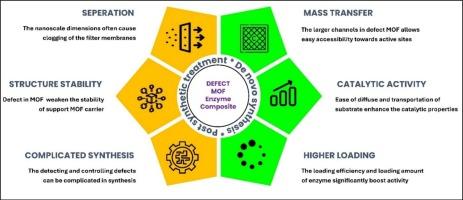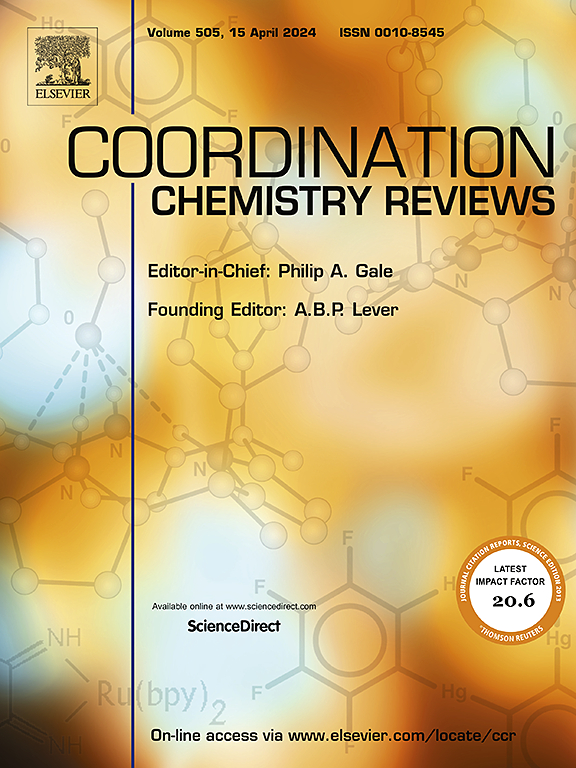Defect metal-organic frameworks (D-MOFs): An engineered nanomaterial for enzyme immobilization
IF 23.5
1区 化学
Q1 CHEMISTRY, INORGANIC & NUCLEAR
引用次数: 0
Abstract
The field of metal-organic frameworks (MOFs) for enzyme immobilization has gained significant traction due to their versatile structural properties and exceptional stability. There are certain constraints after enzyme-MOF composite formation, such as (i) reduction in enzyme activity, (ii) mass transfer limitation between substrate-enzyme, and (iii) unfavorable micro-environment for immobilized enzyme within MOF. Therefore, the defects in MOFs have emerged as a powerful tool to enhance the enzyme catalytic properties and their loading. This review delves into the recent advancements in defect engineering of MOFs, elucidating the role of structural defects in creating mesoporous environments that facilitate superior enzyme immobilization and activity. The synthesis strategies, such as post-synthetic and de-novo methods for controlled defect formation, are comprehensively discussed. Moreover, the integration of machine learning approaches for predicting and optimizing D-MOFs is highlighted, showcasing their transformative impact on biocatalytic applications. The challenges related to synthesis, characterization, enzyme microenvironment, separation, and recycling are critically examined, focusing on the future scope of defect MOFs in sustainable and scalable biocatalysis. This review underscores the untapped potential of defect engineering in MOFs to revolutionize enzyme immobilization, paving the way for innovative biocatalytic processes and applications.


缺陷金属有机框架(D-MOFs):一种用于酶固定化的工程纳米材料
金属有机框架(MOFs)由于其多样的结构特性和优异的稳定性而受到广泛关注。酶-MOF复合物形成后存在一定的限制,如酶活性降低,底物-酶之间传质受限,MOF内固定酶的微环境不利。因此,mof中的缺陷已成为提高酶催化性能和负载的有力工具。本文综述了mof的缺陷工程的最新进展,阐明了结构缺陷在创造介孔环境中的作用,从而促进了更好的酶固定化和活性。全面讨论了控制缺陷形成的后合成法和去novo法等合成策略。此外,还强调了预测和优化d - mof的机器学习方法的集成,展示了它们对生物催化应用的变革性影响。对合成、表征、酶微环境、分离和回收等方面的挑战进行了严格的审查,重点关注可持续和可扩展生物催化中缺陷MOFs的未来范围。这篇综述强调了mof中未开发的缺陷工程在酶固定化方面的潜力,为创新的生物催化工艺和应用铺平了道路。
本文章由计算机程序翻译,如有差异,请以英文原文为准。
求助全文
约1分钟内获得全文
求助全文
来源期刊

Coordination Chemistry Reviews
化学-无机化学与核化学
CiteScore
34.30
自引率
5.30%
发文量
457
审稿时长
54 days
期刊介绍:
Coordination Chemistry Reviews offers rapid publication of review articles on current and significant topics in coordination chemistry, encompassing organometallic, supramolecular, theoretical, and bioinorganic chemistry. It also covers catalysis, materials chemistry, and metal-organic frameworks from a coordination chemistry perspective. Reviews summarize recent developments or discuss specific techniques, welcoming contributions from both established and emerging researchers.
The journal releases special issues on timely subjects, including those featuring contributions from specific regions or conferences. Occasional full-length book articles are also featured. Additionally, special volumes cover annual reviews of main group chemistry, transition metal group chemistry, and organometallic chemistry. These comprehensive reviews are vital resources for those engaged in coordination chemistry, further establishing Coordination Chemistry Reviews as a hub for insightful surveys in inorganic and physical inorganic chemistry.
 求助内容:
求助内容: 应助结果提醒方式:
应助结果提醒方式:


